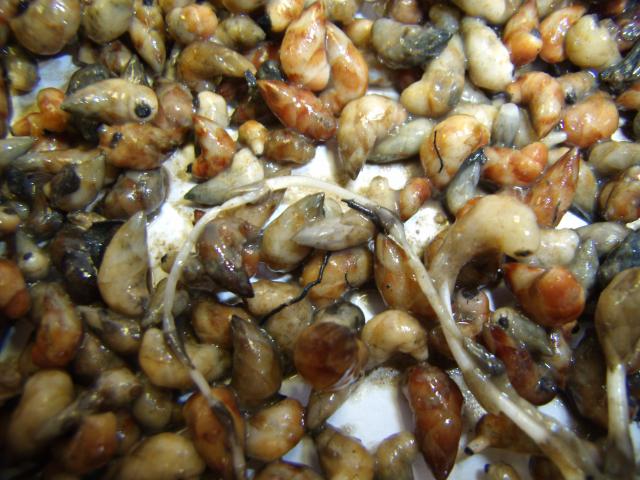
Many of you may read these stories week to week and wonder, “Why don’t they just eradicate this evil plant and move on!?!?!” The problem here is much more “deeply rooted” than most realize. This week we will talk tubers and why they bring management efforts to a crawl in legacy Hydrilla infestations like that in Lake Gaston.
Each week I receive countless calls, emails and letters regarding hydrilla management, especially in regards to the nearly three decade infestation of the plant in Lake Gaston on the North Carolina and Virginia border. I receive logical questions like “Why do we have to treat every year?”, “Why doesn’t the plant disappear from the area after treatment?” and most importantly, “How much longer do we have to keep treating this plant?”. My answer or explanation, in almost every case, is six little letters which define an ENORMOUS obstacle in successful hydrilla management: T-U-B-E-R-S.
Many of you are aware that hydrilla can be spread through the breaking and fragmentation of plant material. The real secret to the invasive plant’s success is its ability to produce structures called tubers. Tubers are pea-sized reproductive structures that form on the roots of hydrilla plants sometimes a half of a foot into the sediment. These structures may look small, but they contribute to the regrowth and regeneration of hydrilla acreages every year in infested lakes. These quarter to half inch long structures come in a variety of colors including white, black and white, orange and white, and can even be found neon orange during some times of the year. Each hydrilla plant produces dozens of these structures every fall meaning thousands of tubers per square meter! Unlike traditional seeds which may sprout every season, tubers have been shown to lie dormant in the sediment for 6,7, or even 8 years before sprouting.
So why are tubers such a problem for management? In untreated areas, hydrilla annually produces more and more tubers, building up a “bank” of survival security. Once an area is treated and the above-ground biomass removed, the tubers below simply sprout and produce a new hydrilla stand the following year. To further complicate the issue, not all tubers sprout in the year following treatment so the “bank” remains intact. The mechanism for tuber sprouting isn’t fully understood but it is thought that as light reaches tubers in an area void of above ground biomass, the tubers sprout and produce new plants. When plants are present above the tubers during a growing season, very little light may reach the sediment and thus, the tubers remain dormant waiting for their call to action. To further complicate the issue, herbicide applications have little to no effect on tubers as they are safely nestled away in the sediment.
For years, funding shortages and the sheer size of the problem in Lake Gaston have led to a “hop-scotch” style of public treatment in which some areas receive treatment one year and others receive treatment the next. While this may have worked to appease homeowners, it has done little to address the very reason hydrilla seems to be a never ending thorn in the side of homeowners, recreational users and county government officials. When treatment lapses for even one year hydrilla tuber banks can regenerate to 75% of their previous years total, leaving us with choked waterways the following summer.
This story isn’t all doom and gloom however. In 2012, a long term management plan for the Lake was revised to include a plan for addressing the tuber problem. Through the selection of long term candidate sites, there may still be hope for reducing hydrilla to manageable levels in Lake Gaston. Furthermore, other lakes in the area (Kerr Lake) should take note of the tuber problem and manage accordingly to avoid becoming a legacy site for the invasive plant. Next time we will discuss the long term plan and the science behind it’s development.
For more information on hydrilla management, visit the AERF’s Best Management Handbook in the “Web Links for Additional Information” or contact me using the information below.
Web Links For Additional Information:
AERF Best Management Practices Handbook
NCSU Hydrilla Page
If you have questions please contact your Aquatic Extension Associate, Brett M. Hartis, at (919)-515-5648 or email at bmhartis@ncsu.edu.


